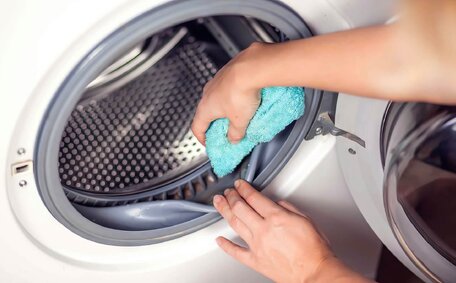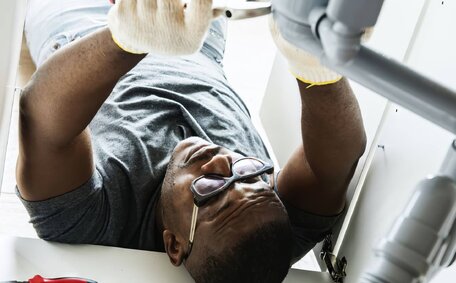Identifying the Location and Cause of the Clog
To tackle a clogged drain, the initial move is to pinpoint the blockage’s location. Common problem areas you should know how to unclog include the kitchen sink, bathroom sink, shower, or toilet. Check each drain meticulously to locate the clog and unclog your drain effectively.
There are a few signs that can indicate a clog’s location. A telltale slow drainage or water pooling can raise suspicions that a blockage in your drain pipe is the likely culprit. Gurgling sounds from the sink drain while water runs can also signal a clog.
After locating the clog, prepare a vinegar and baking soda solution to clear your sink; this mixture typically resolves clogs over time. Typical culprits of your blocked drain include:
- Food waste and grease buildup in your kitchen sink
- Accumulated hair and soap residue in your bathroom sinks or shower drains
- Excessive toilet paper or inappropriate waste in your toilet
Using drain plunging techniques may be sufficient for sending water down your toilet and dislodging blockages, while a mechanical snake is more apt for extracting hair from the pipes.
Trying DIY Methods Before Calling a Professional
Before enlisting a plumber for stubborn clogs, consider a DIY drain cleaner combining bicarb soda and vinegar to break up the obstruction.
A simple method involves mixing baking soda with vinegar—mixing equal parts and pouring the solution into the drain to await results. Pour half a cup of the baking mixture into the drain to directly tackle the blockage. The fizzing reaction between baking soda and vinegar can dissolve blockages made up of grease, hair, and other materials.
Give the mixture time to fizz and work on the blockage by leaving it undisturbed for several minutes.
For optimal results, follow up with a slow pour of boiling water into the drain to help clean the pipes.
Enhance the process by adding baking soda, followed by vinegar, and repeating if necessary to remove all grime.
Regular maintenance with a baking soda and vinegar mixture, followed by boiling water bi-monthly, can prevent clogs from forming.
Using a Plunger
Using plunger techniques comes highly recommended as a straightforward and efficient method to unblock drain blockages in various settings. There are two main types you can use - cup plungers and flange plungers.
Cup plungers, featuring a flat rubber cup, are effectively crafted to tackle clogs in sinks and floor drains. Flange plungers, with their extendable shape, can be as effective as a closet auger for tackling clogs near the overflow hole, ensuring smooth flow in your sink and toilet.
Instead of harsh chemicals, use a plunger to tackle obstructions near garbage disposals:
- Fill the sink with hot water to soften the clog, promoting easier breakdown and passage.
- Ensure the plunger completely cover drain opening, creating a tight seal for effective blockage removal.
- Vigorous plunging motions can remove clog significantly, fostering a clear passageway. Continue for several minutes then assess the progress.
- A sharp pull can create a vacuum, possibly dislodging the clog as the plunger is retracted.
Avoid harsh chemicals in drain cleaners and consider safer alternatives like hot water to keep drains clear and protect plumbing. Opt for hot water or even a squirt of dish soap to assist and protect your pipes.
If plunging is ineffective, a drain auger may be necessary to reach and remove deeper pipe buildup.
Baking Soda, Vinegar and Boiling Water
For a clogged toilet, using baking soda, white vinegar, and boiling water is an effective method to break up tough clogs.
Begin the process by sprinkling a cup baking soda into the drain to clear your blockage, and shortly thereafter, add an equal amount of vinegar. The chemical reaction between the baking soda and vinegar releases bubbles and fizzing to help dissolve grease, hair soap scum, and other debris.
Allow the concoction of baking soda and cold water to let sit 2030 minutes then check to see if the blockage has been removed. This gives the fizzing and bubbles time to penetrate and work on the clog.
With care, dispense boiling water from the stove to clear clogged drain effectively. Take care to pour gently over drain. The rushing hot water helps flush away any grime and buildup loosened by the baking soda and vinegar mixture.
You can repeat this process a few times if needed, letting the drain sit for some minutes after each application before flushing with more boiling water. The combination of the chemical reaction and flushing boiling water provides a one-two punch to clear out even stubborn clogs.
Do not replace cautious handling with haste when working with boiling water to avoid injury. Wear gloves and eye protection, keep children and pets away, and pour slowly to prevent splashing.
Snaking the Drain
When common methods disappoint, such as using a homemade drain cleaner of baking soda, vinegar, and boiling water, think about manually snaking the drain before enlisting a professional’s assistance.
Drain augers, capable of snake into the depths of your plumbing, are flexible cables designed for the physical removal of blockages. Insert 3-6 feet of the snake down the drain and twist gently to catch debris.
Gently utilise the snake with a 'can pull’ method, rotating it to effectively navigate and free the clog along with any trapped debris.
For bathroom sinks, a drain snake can often reach further down the pipe, efficiently tackling blockages in the trap or distant areas. Drain snakes are useful for dislodging stubborn clogs deeper in the pipes while protecting the drain can surface.
Take care not to damage pipes or scratch surfaces when using a cable auger for snaking drains. Insert and pull back slowly. If attempts with a plumbers snake fail, a professional plumber has commercial-grade high powered augers that can clear even the most stubborn clogs.
Advanced Methods for Severe Clogs
When DIY methods fail to clear a severely clogged drain, it’s time to call in the professionals for advanced solutions. Methods like hydro-jetting and Roto-Rooter use commercial-grade equipment and expertise to clear even the toughest blockages.
Hydro-jetting, also known as drain jetting, uses an intensive high-pressure water spray to scour pipe interiors and forcibly flush away years of accumulated gunk. Roto-Rooter employs a rapidly spinning auger with cutting blades to shred through stubborn blockages.
These powerful techniques can overcome major blockages, similar to sending boiling water down pipe to remove tough clogs:
- Extensive buildup of hair, grease, and waste in your shower drain deep in pipes
- Large items accidently flushed down like toys or towels
- Pipe damage from shifting foundations can cause severe issues in your drainage system
- Invasive tree roots growing into and cracking underground pipes
Because of the power equipment involved, it’s crucial advanced drain cleaning methods are only conducted by qualified professionals. However, when faced with major clog issues unresolved by basic DIY approaches, hydro-jetting and mechanical snaking provide extreme unclogging capabilities.
The pros have cameras to inspect inside drains and advanced tools to smash severe clogs down your drain without damaging the integrity of your plumbing system.
Hydro-Jetting
Hydro-jetting is an advanced drain cleaning method used to remove severe blockages deep within pipes. It involves firing an intense jet stream of high-pressure hot water into the pipe to scour away years of accumulated gunk, grease, and debris.
To perform hydro-jetting, licenced plumbers use an industrial hydraulic jetter unit connected to a flexible hose fed down the pipe. Pressures can range from 5,000 to 15,000 PSI blasting contaminated pipe interiors to keep the drain clear.
Hydro-jetting is the most effective technique at scrubbing entire plumbing systems, propelling pressurized spray deep into pipes, even around bends where standard drain snakes falter.
eliminating current clogs, hydro-jet flushes help prevent future buildup by cleaning the full length of drains. It’s perfect for both routine maintenance and emergency drain cleaning jobs.
However, the intense water pressure requires certified hydro-jet operators to avoid pipe damage. Attempting to DIY with jet sprayers from hardware stores can destroy pipe integrity and cause leaks or flooding.
Roto-Rooter
Roto-Rooter is a powerful mechanical drain cleaning service used to remove stubborn clogs, especially tree roots growing into pipes. A rapidly spinning auger (like a long drill bit) with sharp cutting edges is fed down the pipe while rotating at high speeds to shred and dislodge blockages.
The Roto-Rooter approach can work wonders when slicing through resistant materials like tree roots, grease clumps, and substantial debris lodged deep in your pipes. It thoroughly clears current obstructions while scouring the pipe walls smooth to prevent future buildup.
Even with smaller manual augers available for DIY, professional Roto-Rooter machinery can tackle drain blockages more effectively, preventing a build up beyond what standard augers can manage.
For extensive root intrusion or years of embedded gunk accumulation that basic snaking can’t fix, Roto-Rooter services expertly restore proper drainage. It’s crucial to have a qualified plumber perform this intense mechanical cleaning to avoid pipe damage.
If your exterior or main sewer line has draining issues unresolved by at-home methods, contact the professional Roto-Rooter plumbers at Cambridge Park Plumbing for an evaluation of your system.
Preventing Future Clogs
There are several methods to help prevent clogs from occurring in the first place:
- Use sink strainers to catch food waste, hair, and other debris before it goes down the drain
- Avoid pouring fats, oils, and grease down the sink. Let it cool and dispose of it in the trash.
- Only flush toilet paper and human waste down toilets to avoid backups
- Don’t flush non-dissolvable items like wipes or hygiene products
- Consider installing hair catchers in shower and sink drains
- Regularly pour a mix of boiling water to combine with baking soda into drains monthly to unclog your pipes and prevent buildup
Adopting proactive habits can keep your drains free from potential drain clogs. Small drain blockages can compound over time into major obstructions. An ounce of prevention by discarding debris properly, using sink strainers, and maintaining clear pipes saves the headache of a severely clogged drain system.
Should you believe your drains demand a more thorough cleanse, Cambridge Park Plumbing’s licensed team offers professional plumbing services for preventative maintenance, ensuring pipes stay clear.
When to Call a Professional Plumber
DIY drain cleaning methods like plungers, baking soda and vinegar treatments, and snaking cables can often resolve minor to moderate clogs. However, if efforts to handle severe or recurring blockages prove fruitless, it’s wise to acknowledge a drain clogged can require professional attention.
Signs that beg the question 'how do I clear this?' include water backing up from multiple drains, complete blockages that cause overflows, or foul sewage odours coming from main lines. These can signal serious issues like pipe damage, tree root invasion, or major buildup accumulation.
If you’ve cautiously followed DIY procedures but clogs persist, your clogged drains likely require commercial-grade hydro-jetting or mechanical augering options for thorough cleaning.
Our licenced technicians at Cambridge Park Plumbing have advanced tools and cameras to safely inspect the full extent of drainage problems and do clear blocked passages. We determine whether sections of damaged piping need repair or replacement for preventative maintenance against future disasters.
Dont wait until minor clogs become hugely expensive emergencies. At the first sign of stubborn recurring issues, call our specialists for reliable solutions. Protect your home with our Drainage Cleanup package.





